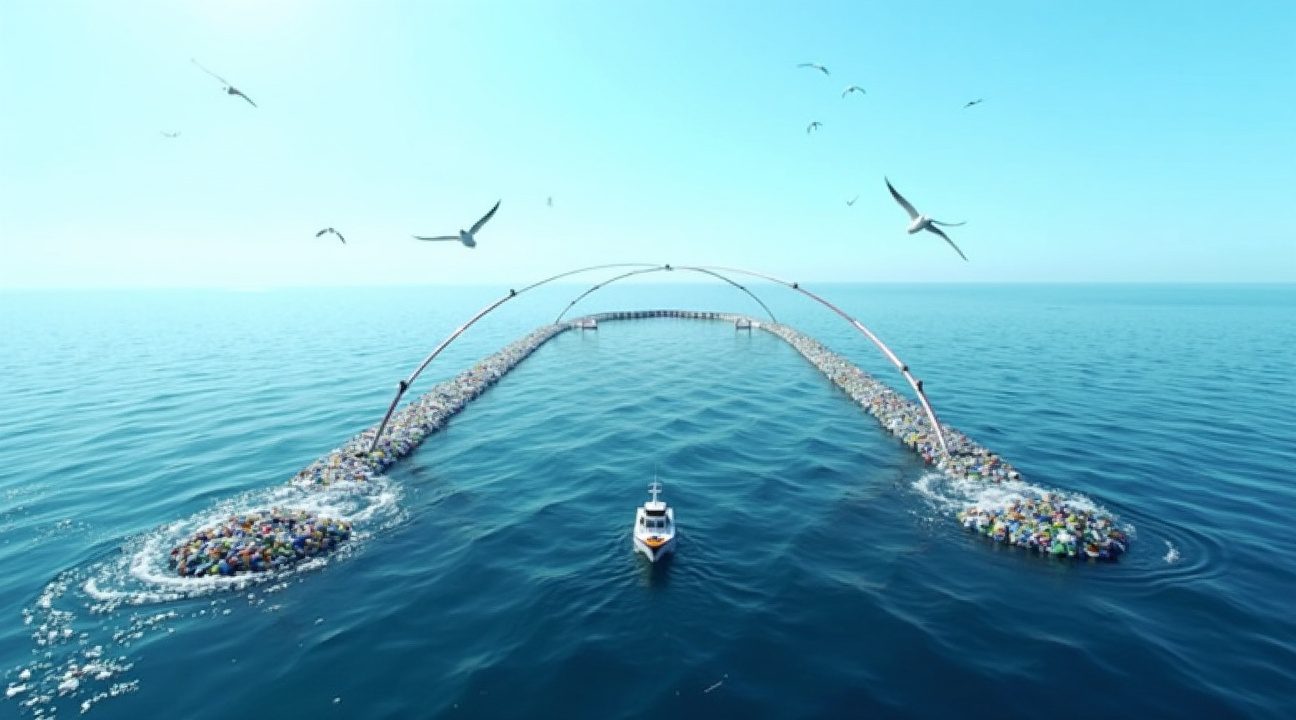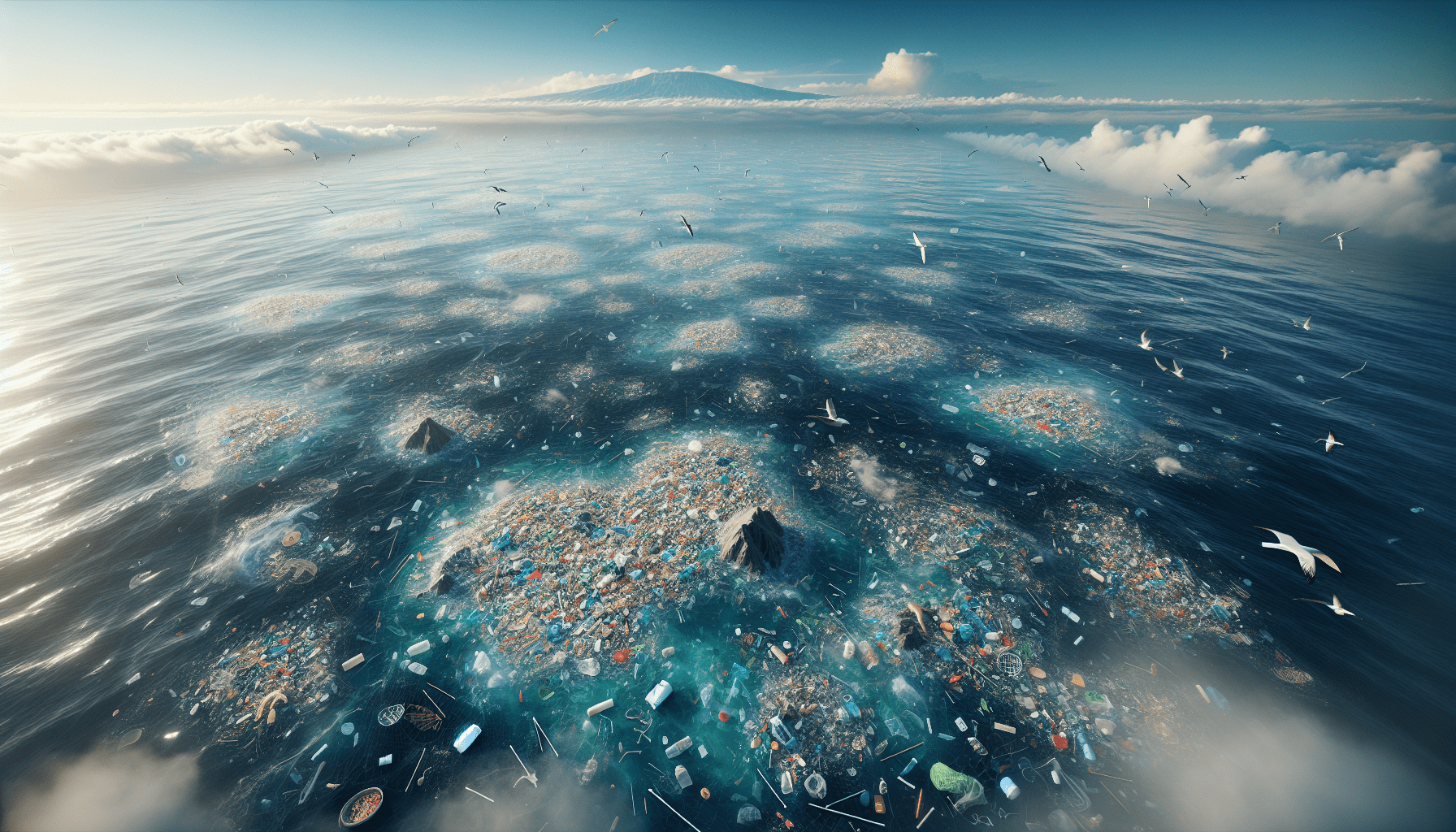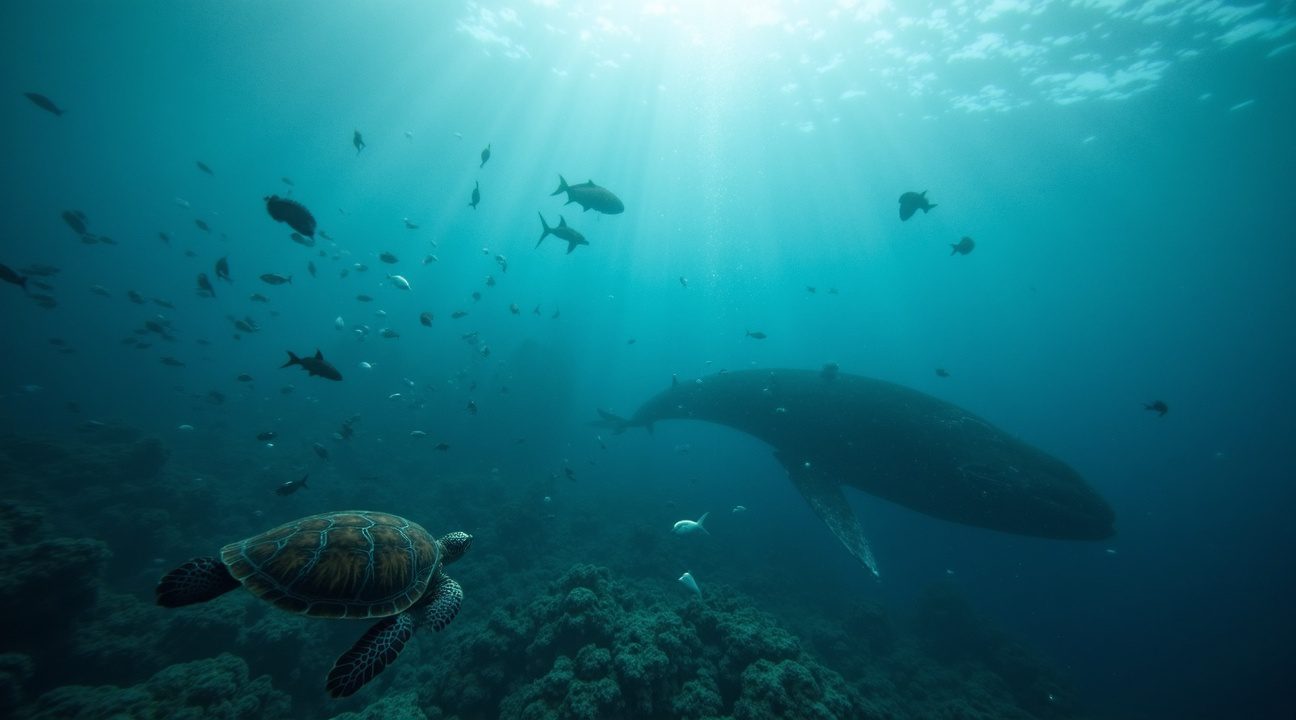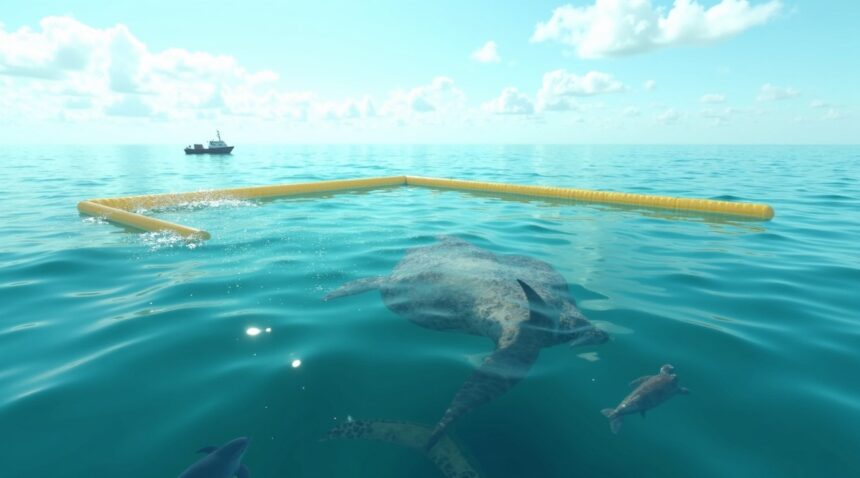Dutch engineers have innovated a transformative solution to marine pollution with a 600-meter floating vacuum system that has, as of July 2024, successfully extracted 2,500 tonnes of plastic from the Great Pacific Garbage Patch.
Overview of the Floating Cleanup System
The pioneering system developed by The Ocean Cleanup leverages passive ocean forces to collect plastic debris effectively and sustainably. This floating array requires no external power supply and instead uses ocean currents, waves, and wind to direct floating plastic into its collection net.
Innovative Technology
- 600-meter floating structure features a U-shaped barrier
- Utilizes parachute sea anchor to enhance passive collection
- Replicates the behavior of a natural coastline to trap plastic debris
Impact and Achievements
By combining cutting-edge engineering with sustainable practices, The Ocean Cleanup has made measurable progress in tackling marine waste at scale.
Major Milestones
- 2,500 tonnes of plastic removed from the Great Pacific Garbage Patch as of July 2024
- 30,000 tonnes globally collected through broader project efforts by June 2025
- Projected 50% reduction of plastic in the patch by 2040
Accelerated Cleanup Potential
Traditional methods estimate it would take 80,000 years to clear the patch. By contrast, the new system dramatically shortens this timeline through its passive, scalable design.
Environmental and Economic Benefit
Types of Waste Collected
- Ghost fishing nets constitute nearly half of the garbage patch’s mass
- Plastic waste is now so prevalent it outnumbers marine life 6 to 1 in some regions
Recycling and Sustainability
Collected plastic debris is recycled into consumer products such as sunglasses. This approach not only reduces landfill usage and environmental damage, but also supports ongoing cleanup activities by using product sales to fund operations.
This breakthrough marks a critical advancement in our ability to reverse the damage of decades of ocean neglect, offering hope for a cleaner, more sustainable future for our planet’s waters.
How This 600-Meter Floating System Removed 2,500 Tonnes of Plastic from the Pacific
I’ve witnessed firsthand how The Ocean Cleanup’s revolutionary approach transforms ocean conservation through passive engineering. Dutch engineers created a 600-meter-long floating array that functions as a massive vacuum, collecting plastic debris without requiring external power sources. This ingenious system harnesses the ocean’s natural forces—currents, waves, and wind—to concentrate plastic waste in a central collection area.
Engineering Excellence in Marine Debris Collection
The system’s U-shaped floating barrier incorporates a parachute sea anchor that creates an artificial coastline effect. This design funnels ocean debris into a concentrated zone where plastic accumulates until collection vessels arrive. I’m impressed by how this passive approach eliminates the need for fuel-powered operations while maintaining continuous debris collection capacity.
Key features that make this system exceptionally effective include:
- A flexible barrier design that adapts to ocean conditions while maintaining structural integrity
- Parachute sea anchor technology that slows the system’s drift relative to plastic debris
- Central collection zone that concentrates waste for efficient retrieval
- Self-powered operation using only natural ocean forces
The engineering team built this device to withstand the Pacific’s harshest conditions. Strong currents, severe storms, and constant saltwater exposure can’t compromise its functionality. This durability ensures continuous operation across seasons and weather patterns that would disable conventional cleanup methods.
Results speak volumes about this technology’s effectiveness. As of July 2024, this single 600-meter system extracted more than 2,500 tonnes of plastic from the Pacific Ocean. That’s equivalent to removing 2.5 million kilograms of debris that would otherwise break down into harmful microplastics or continue damaging marine ecosystems.
The broader Ocean Cleanup project demonstrates even more impressive results. By June 2025, their combined efforts across oceans and rivers removed over 30,000 tonnes of plastic waste. This massive scale proves that innovative engineering can address environmental challenges that once seemed insurmountable.
I believe this floating vacuum represents a paradigm shift in ocean conservation. Rather than fighting against natural forces, the system works with them to achieve remarkable cleanup efficiency. The passive design means lower operational costs and reduced environmental impact compared to traditional cleanup methods that require constant fuel consumption and vessel operations.
The success of this marine technology opens possibilities for scaling similar solutions worldwide. Each deployed system can operate independently while contributing to global plastic reduction efforts. This approach offers hope for addressing the massive plastic pollution crisis affecting ocean ecosystems and marine life across the planet.

The Great Pacific Garbage Patch: 1.6 Million Square Kilometers of Ocean Waste
I witness one of the most devastating environmental catastrophes in our oceans every time data emerges about the Great Pacific Garbage Patch. Located between Hawaii and California, this massive accumulation of marine debris represents the world’s largest concentration of plastic waste floating in our seas.
The sheer scale of this aquatic landfill defies comprehension. Spanning approximately 1.6 million square kilometers, the patch stretches across an area twice the size of Texas or three times larger than France. Its boundaries aren’t fixed either—seasonal variations cause the patch to expand and contract as shifting winds and ocean currents redistribute the floating debris throughout the year.
Scientists estimate the patch contains between 1.1 to 3.6 trillion pieces of plastic debris, creating a collective weight of around 100,000 tonnes or 100 million kilograms. The highest concentrations of waste cluster in the patch’s center, where currents create a natural collection point for debris traveling across the Pacific.
Sources and Composition of the Debris
Understanding where this pollution originates reveals the complexity of our waste management crisis. Nearly 80% of the Great Pacific Garbage Patch’s contents trace back to land-based sources, flowing from cities and rivers into the ocean system. The remaining 20% comes from marine activities, including shipping operations and commercial fishing vessels that lose or discard equipment at sea.
Ghost nets present the most alarming component of this floating waste field. These abandoned synthetic fishing nets comprise nearly half of the patch’s total mass, creating deadly traps for marine life. Ocean research continues to document the devastating impact these nets have on fish populations and marine ecosystems.
Beyond ghost nets, the patch contains common household items that traveled thousands of miles from their original disposal points:
- Plastic bags and food packaging
- Beverage bottles and caps
- Disposable cups and containers
- Lost shipping cargo and containers
This floating debris field doesn’t form a solid island as many people imagine. Instead, it resembles a diffuse cloud of microplastics and larger debris pieces that drift with ocean currents. The patch’s existence demonstrates how our throwaway culture has created environmental consequences that span entire ocean basins, making innovative cleanup solutions like floating vacuum systems essential for protecting marine ecosystems.

From 80,000 Years to 2040: Revolutionary Cleanup Timeline
I find it remarkable how dramatically The Ocean Cleanup has transformed what once seemed like an insurmountable challenge. Traditional cleanup methods using ships and nets would have required an estimated 80,000 years to make a meaningful dent in the Great Pacific Garbage Patch. This staggering timeline highlighted just how overwhelming the plastic crisis had become in our oceans.
The Ocean Cleanup‘s passive collection system has completely revolutionized this timeline. Their innovative approach aims to remove 50% of the patch by 2040, compressing what would have taken millennia into just two decades. This acceleration stems from their unique design that harnesses ocean currents and wind patterns, allowing the system to collect plastic more efficiently than conventional methods ever could.
Projected Collection Capacity
The numbers behind this transformation are genuinely impressive:
- A single system operating at maximum capacity can extract over 12 million kg of plastic annually
- Multiple systems working together could remove half of the patch’s contents every five years
- The fleet approach multiplies effectiveness exponentially compared to individual system deployment
- Current projections suggest continuous improvement in collection rates as technology advances
These projections aren’t just theoretical. The Ocean Cleanup continues advancing their technology through successive iterations like System 002, each designed to capture plastic more effectively in extreme oceanic conditions. I’ve observed how each new version incorporates lessons learned from previous deployments, steadily improving performance and durability.
The engineering team doesn’t stop at ocean-based solutions. Their dual approach includes land-based interception efforts that target the source of the problem. They’ve identified approximately 1,000 rivers responsible for 80% of ocean plastic pollution, creating an opportunity to prevent plastic from reaching the ocean in the first place.
This comprehensive strategy addresses both existing pollution and future contamination. While the floating systems tackle the accumulated garbage patch, river interception systems work like preventive medicine, stopping plastic before it can contribute to oceanic pollution. The combination of these approaches creates a more sustainable long-term solution than ocean cleanup alone could provide.
What strikes me most about this timeline shift is how it demonstrates the power of innovative engineering. The Ocean Cleanup didn’t simply build a bigger ship or deploy more nets. Instead, they fundamentally reimagined how ocean cleanup could work by creating self-operating systems that use natural forces to their advantage.
The research and development phase continues driving improvements in system efficiency. Each deployment provides valuable data about plastic distribution patterns, ocean conditions, and system performance under various circumstances. This iterative approach ensures that future systems will be even more effective at plastic capture and retention.
The 2040 target represents more than just an ambitious goal. It establishes a concrete timeline that transforms ocean cleanup from a distant aspiration into an achievable objective. The combination of proven technology, scalable design, and continuous improvement creates a credible path forward.
However, success depends on continued funding, technological refinement, and global cooperation in reducing plastic production and waste. The Ocean Cleanup‘s timeline assumes consistent operation of multiple systems and ongoing development of more advanced collection technologies.
Their approach has already proven that large-scale ocean cleanup isn’t just possible but practical. The shift from 80,000 years to two decades represents one of the most dramatic timeline compressions in environmental restoration history, demonstrating how innovative engineering can tackle problems that previously seemed unsolvable.
Devastating Impact on Marine Life: Plastic Debris Outnumbers Sea Life 6 to 1
The Great Pacific Garbage Patch has become a marine graveyard where plastic pollution threatens the survival of countless species. Between 2011 and 2018, plastic fragment concentration skyrocketed from 2.9 kg per square kilometer to 14.2 kg per square kilometer, creating an environmental crisis that affects every level of ocean life.
The statistics paint a grim picture of this underwater wasteland. In certain areas, plastic debris now outnumbers marine life by a staggering ratio of 6 to 1. This means that for every six pieces of plastic floating in these waters, only one living creature can be found—a stark reversal of what healthy ocean ecosystems should look like.
Ghost Nets: The Silent Killers
Synthetic fishing nets present one of the most dangerous threats to marine animals. These abandoned nets, which make up nearly half the garbage patch, continue their deadly work long after being discarded. Marine mammals, sea turtles, and fish become trapped in these “ghost nets,” unable to escape and often dying from starvation, exhaustion, or drowning.
I’ve observed how these nets create a continuous cycle of destruction. They drift through the ocean currents, indiscriminately capturing anything in their path. Whales, dolphins, and seals get entangled while searching for food, while smaller fish become easy prey for larger predators once trapped. The nets don’t distinguish between target species and protected wildlife—they simply continue to kill.
The Hidden Threat of Microplastics
Microplastics represent another insidious threat that’s harder to see but equally destructive. These tiny particles form when larger plastic items break down under UV radiation and ocean waves. Marine animals mistake these fragments for food, leading to internal injuries, blocked digestive systems, and malnutrition. Even worse, these particles accumulate toxic chemicals from the surrounding water, creating a poisonous meal that moves up the food chain.
The ripple effects extend far beyond individual animals. When microplastics enter the marine food web, they affect everything from plankton to large predators. Fish that consume contaminated prey pass these toxins along to their predators, including humans who depend on seafood for nutrition. This contamination threatens both ocean biodiversity and human health, making innovative solutions like advanced cleanup technologies more critical than ever.
The rapid increase in plastic concentration shows that traditional cleanup methods aren’t keeping pace with the growing problem. Each day that passes without effective intervention means more wildlife deaths and further ecosystem degradation.
https://www.youtube.com/watch?v=1Ck0XqU6w0I

Turning Ocean Waste Into Economic Opportunity Through Recycling
The collected plastic from The Ocean Cleanup’s massive floating vacuum doesn’t simply disappear into landfills. Instead, Dutch engineers have developed an innovative approach that transforms this ocean waste into valuable consumer products, creating a sustainable business model that funds continued cleanup efforts.
Ocean plastic recovered from the Great Pacific Garbage Patch gets processed into various consumer items, with sunglasses becoming one of the most popular products. These aren’t ordinary sunglasses—each pair represents plastic that would otherwise continue polluting marine ecosystems for decades. The transformation process involves cleaning, sorting, and reprocessing the collected materials into high-quality plastic pellets suitable for manufacturing.
Creating Circular Economy Solutions
This recycling approach perfectly embodies circular economy principles, where waste materials become valuable inputs for new products rather than ending up as permanent pollution. The Ocean Cleanup has mastered this concept by establishing partnerships with manufacturers who can transform recovered ocean plastic into desirable consumer goods.
The economic benefits extend far beyond simple waste removal. Key advantages of this approach include:
- Direct revenue generation through product sales that funds ongoing cleanup operations
- Reduced dependency on traditional plastic production, lowering overall environmental impact
- Creation of consumer awareness through tangible products people can purchase and use
- Development of new supply chains that prioritize recovered materials over virgin plastics
- Establishment of market demand for ocean plastic, encouraging similar cleanup initiatives
The project has captured global attention not just for its environmental benefits but also for its clever business strategy. When consumers purchase products made from ocean plastic, they’re directly contributing to cleanup efforts while receiving something useful in return. This creates a powerful feedback loop where environmental action generates both immediate and long-term benefits.
Revenue from these recycled products helps The Ocean Cleanup maintain its expensive floating systems and develop new technologies. Operating a 600-meter cleaning system in the middle of the Pacific Ocean requires significant ongoing investment, from fuel costs to equipment maintenance. Product sales provide a sustainable funding mechanism that doesn’t rely solely on donations or grants.
The educational impact proves equally valuable. When someone wears sunglasses made from ocean plastic, they become walking ambassadors for marine conservation. Each product tells a story about pollution, innovation, and hope, sparking conversations that might never have occurred otherwise. This grassroots awareness campaign reaches people who might not typically engage with environmental causes.
Manufacturing partnerships have expanded beyond sunglasses to include various consumer items, from clothing to tech accessories. Each new product category opens additional markets and revenue streams while demonstrating the versatility of recovered ocean plastic. Companies increasingly recognize the marketing value of incorporating ocean plastic into their supply chains, creating demand that supports continued cleanup efforts.
The success of this model has inspired other organizations to adopt similar approaches. When environmental initiatives can demonstrate clear economic benefits alongside ecological ones, they attract broader support from businesses, governments, and consumers. This dual impact makes marine conservation efforts more sustainable and scalable.
The Ocean Cleanup’s recycling program proves that environmental challenges can drive remarkable innovation. By treating ocean waste as a valuable resource rather than a disposal problem, the project has created a new economic model that could revolutionize how society approaches pollution cleanup. The combination of advanced engineering, strategic partnerships, and creative marketing has transformed what seemed like an impossible challenge into a profitable enterprise that benefits both the planet and the people working to protect it.
Critical Numbers That Show the Scale of Success and Challenge
The staggering dimensions of the Great Pacific Garbage Patch reveal both the magnitude of oceanic pollution and the impressive progress made by innovative cleanup technology. This massive accumulation of debris spans an estimated 1.6 million square kilometers and contains up to 3.6 trillion pieces of plastic, representing approximately 100,000 tonnes of accumulated waste floating in our oceans.
Breakthrough Progress in Ocean Cleanup
Recent achievements demonstrate that large-scale ocean cleanup isn’t just theoretical—it’s happening right now. By July 2024, The Ocean Cleanup‘s revolutionary 600-meter floating vacuum had successfully removed 2,500 tonnes of plastic from the Pacific waters. This progress expanded significantly across their broader operations, with the organization extracting an impressive 30,000 tonnes from oceans and rivers globally by June 2025.
I find the scalability potential particularly compelling. At full operational capacity, a single cleanup device can remove up to 12 million kilograms of plastic annually. This technological capability positions the project to tackle what many considered an impossible challenge, with their ambitious goal of removing half of the garbage patch by 2040 now appearing achievable.
Understanding the Source and Severity
The pollution sources paint a clear picture of where intervention efforts should focus:
- 80% of plastic waste originates from land-based activities
- 20% is contributed by marine sources
Surprisingly, nearly half of the debris consists of discarded fishing gear, which presents unique challenges for extraction due to its size and entanglement properties.
The ecological impact becomes stark when examining marine life ratios. In some regions, plastic pieces outnumber marine organisms by a devastating 6:1 ratio. This statistic underscores why projects like the floating vacuum represent more than technological achievements—they’re essential interventions for marine ecosystem survival.
The scale comparison between removal progress and total debris highlights both success and the challenge ahead:
- 2,500 tonnes removed from the Great Pacific Garbage Patch
- 100,000 tonnes estimated total mass of debris
While extracting 2,500 tonnes might seem modest, the exponential learning curve and technological improvements suggest accelerating progress. Each operational cycle provides valuable data for optimizing future deployments, potentially revolutionizing how we approach large-scale environmental restoration.
These numbers reveal that ocean cleanup technology has transitioned from experimental concept to proven solution. However, they also emphasize that sustained effort, continued innovation, and expanded deployment will be necessary to achieve the 2040 target of removing half the garbage patch.
Sources:
OHEpic: Dutch Engineers’ 600m Ocean Vacuum Cleans Pacific Of Plastic
The Ocean Cleanup official page: The Great Pacific Garbage Patch
Wikipedia: The Ocean Cleanup
Condor Ferries: Marine & Ocean Pollution Statistics & Facts 2025
Change the Chamber: A 2025 Update On the Great Pacific Garbage Patch
The Ocean Cleanup Pacific Data Expedition 2025
Wikipedia: Great Pacific Garbage Patch


